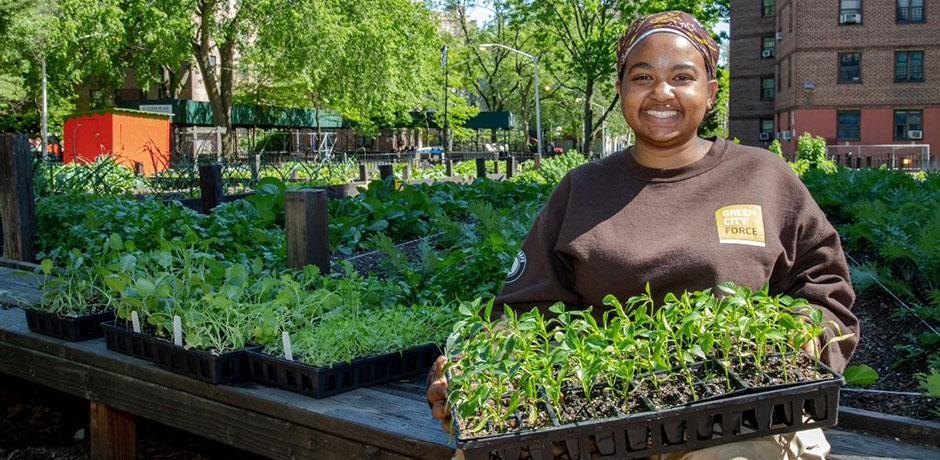The smart Trick of City Blooming That Nobody is Talking About
The smart Trick of City Blooming That Nobody is Talking About
Blog Article
Get This Report on City Blooming
Table of ContentsThe Main Principles Of City Blooming Get This Report about City BloomingHow City Blooming can Save You Time, Stress, and Money.Not known Factual Statements About City Blooming Getting The City Blooming To Work
Fascinated in growing food available for sale in the City of Chicago? Believing regarding beginning an area garden? Modifications to the Chicago Zoning Regulation enable agricultural uses like community gardens and urban ranches in lots of components of the city. Below is a list of frequently asked inquiries regarding the policies and guidelines that cultivators ought to consider when preparing a metropolitan farming job.
The zoning change does not change any kind of other codes managing composting, building authorizations, buying or leasing City owned residential or commercial property, business licenses or environmental contamination. There are existing codes that manage these concerns and they stay in full impact and may be appropriate to your project. Area gardens are normally possessed or managed by public entities, civic companies or community-based organizations and kept by volunteers.
Urban farms grow food that is planned to be sold, either on a not-for-profit or for-profit basis. Due to their industrial purpose, city farms need an organization certificate.
The 30-Second Trick For City Blooming
Composting is allowed however just for plant material that is produced and utilized on website. The amount of garden compost material can not exceed 25 cubic yards at any type of offered time according to the criteria in 7-28-715 of the City's Municipal Code. Yes. Since the dirt at the majority of new yard websites needs changing, compost, dirt, wood chips, or various other materials can be acquired to create or improve the expanding space - fruit and vegtables.

If a structure permit is required then the hoophouse will be thought about an accessory structure. You can find out more about the structure permit requirements by calling the Department of Structures. The 25,000-square-foot dimension limitation is intended to avoid a single neighborhood yard from dominating a given block or diminishing the block's existing residential or business character.
The restriction does not use to yards located in Public Open Room (POS) areas. Can there be greater than one neighborhood garden that is 25,000 square feet on a solitary block? Yes. The dimension limit relates to individual yards, not to individual blocks. No. Fencing is not needed, nonetheless, yards that have huge parking lot might be called for to mount fence or other landscaping functions.
Unknown Facts About City Blooming
B1 & B2 districts call for that all commercial usage tasks be performed inside your home. Is fencing required for city farms? Fencings might be needed, along with landscaping and testing, for particular car park areas and outdoor job or storage space areas depending on place and the details activity taking place.
Yes. Urban farms need structure permits and zoning approvals prior to construction. Other kinds of city evaluation may be required depending on particular structures, activities, dimension, landscaping, licensing, public health and stormwater monitoring issues. Most of these demands are recognized in the project design or allowing process, nevertheless, the candidate may be accountable to separately recognize particular licenses or allows that may be called for.
Yes. The kind of permit is determined by what is taking place at the site. The Division of Business Matters and Customer Defense can assist figure out the particular sort of service license that's called for. Yes. Off street auto parking is needed for most industrial tasks in Chicago. The needed number of garage is based on the variety of employees dealing with website and find here not the square footage of the growing space.
City Blooming for Dummies

Yes. A metropolitan ranch can offer garden compost product created on website, nevertheless, the operation needs to conform with the guidelines in 7-28-715 of the Chicago Municipal Code. Yes. Aquaponic systems are enabled indoors on city farms in lots of zoning districts. A zoning review and structure authorization is needed in order to set up frameworks or systems and a company certificate is needed as described over.
As much as 5 hives or nests of honey bees might be maintained as an accessory usage. Nonetheless, beekeepers must register with the Illinois Division of Agriculture. For even more info concerning the proposed zoning amendment you might contact the Division of Real Estate and Economic Growth, Bureau of Planning and Zoning at 312.744.8563.
Farming in cities and urban locations A metropolitan ranch in Chicago. Urban farming refers to numerous methods of cultivating. https://worldcosplay.net/member/1784867, handling, and dispersing food in metropolitan locations. The term likewise applies to the area tasks of animal husbandry, aquaculture, beekeeping, and horticulture in an urban context. Urban agriculture is differentiated from peri-urban agriculture, which takes place in rural locations at the side of residential areas.
Getting My City Blooming To Work
It can include an activity of natural cultivators, "foodies" and "locavores", who look for to form socials media started on a shared values of nature and neighborhood holism. These networks can develop using official institutional assistance, ending up being incorporated into regional community planning as a "change community" motion for lasting urban growth.
The extra direct access to fresh veggie, fruit, and meat items that might be become aware through metropolitan farming can boost food safety and security and food safety and security while decreasing food miles, leading to lower greenhouse gas exhausts, thereby adding to environment change reduction. Some of the initial proof of metropolitan agriculture originates from Mesopotamia.
Report this page